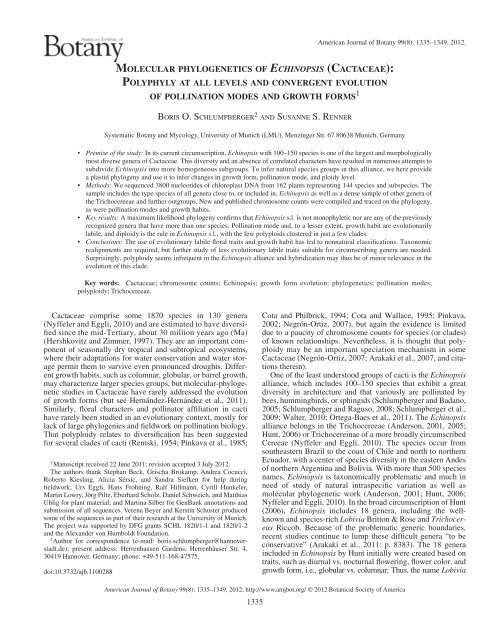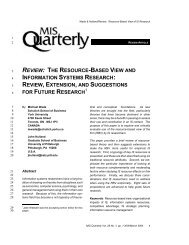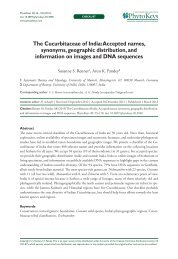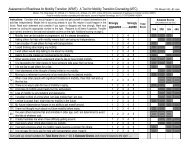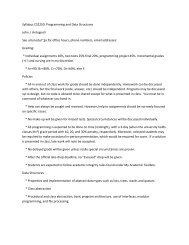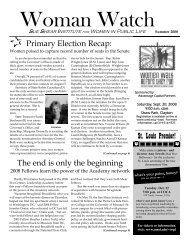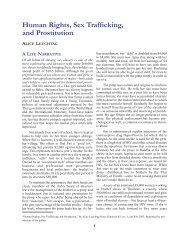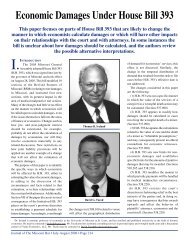molecular phylogenetics of echinopsis (cactaceae)
molecular phylogenetics of echinopsis (cactaceae)
molecular phylogenetics of echinopsis (cactaceae)
Create successful ePaper yourself
Turn your PDF publications into a flip-book with our unique Google optimized e-Paper software.
Cactaceae comprise some 1870 species in 130 genera<br />
( Nyffeler and Eggli, 2010 ) and are estimated to have diversifi<br />
ed since the mid-Tertiary, about 30 million years ago (Ma)<br />
( Hershkovitz and Zimmer, 1997 ). They are an important component<br />
<strong>of</strong> seasonally dry tropical and subtropical ecosystems,<br />
where their adaptations for water conservation and water storage<br />
permit them to survive even pronounced droughts. Different<br />
growth habits, such as columnar, globular, or barrel growth,<br />
may characterize larger species groups, but <strong>molecular</strong>-phylogenetic<br />
studies in Cactaceae have rarely addressed the evolution<br />
<strong>of</strong> growth forms (but see Hernández-Hernández et al., 2011 ).<br />
Similarly, fl oral characters and pollinator affi liation in cacti<br />
have rarely been studied in an evolutionary context, mostly for<br />
lack <strong>of</strong> large phylogenies and fi eldwork on pollination biology.<br />
That polyploidy relates to diversifi cation has been suggested<br />
for several clades <strong>of</strong> cacti ( Remski, 1954 ; Pinkava et al., 1985 ;<br />
1 Manuscript received 22 June 2011; revision accepted 3 July 2012.<br />
The authors thank Stephan Beck, Grischa Brokamp, Andrea Cocucci,<br />
Roberto Kiesling, Alicia Sérsic, and Sandra Siefken for help during<br />
fi eldwork; Urs Eggli, Hans Frohning, Ralf Hillmann, Cyrill Hunkeler,<br />
Martin Lowry, Jörg Piltz, Eberhard Scholz, Daniel Schweich, and Matthias<br />
Uhlig for plant material; and Martina Silber for GenBank annotations and<br />
submission <strong>of</strong> all sequences. Verena Beyer and Kerstin Schuster produced<br />
some <strong>of</strong> the sequences as part <strong>of</strong> their research at the University <strong>of</strong> Munich.<br />
The project was supported by DFG grants SCHL 1820/1-1 and 1820/1-2<br />
and the Alexander von Humboldt Foundation.<br />
2 Author for correspondence (e-mail: boris.schlumpberger@hannoverstadt.de<br />
); present address: Herrenhausen Gardens, Herrenhäuser Str. 4,<br />
30419 Hannover, Germany; phone: +49-511-168-47575,<br />
doi:10.3732/ajb.1100288<br />
1335<br />
American Journal <strong>of</strong> Botany 99(8): 1335–1349. 2012.<br />
M OLECULAR PHYLOGENETICS OF E CHINOPSIS (CACTACEAE):<br />
P OLYPHYLY AT ALL LEVELS AND CONVERGENT EVOLUTION<br />
OF POLLINATION MODES AND GROWTH FORMS 1<br />
B ORIS<br />
O.<br />
SCHLUMPBERGER 2 AND S USANNE<br />
Cota and Philbrick, 1994 ; Cota and Wallace, 1995 ; Pinkava,<br />
2002 ; Negrón-Ortiz, 2007 ), but again the evidence is limited<br />
due to a paucity <strong>of</strong> chromosome counts for species (or clades)<br />
<strong>of</strong> known relationships. Nevertheless, it is thought that polyploidy<br />
may be an important speciation mechanism in some<br />
Cactaceae ( Negrón-Ortiz, 2007 ; Arakaki et al., 2007 , and citations<br />
therein).<br />
One <strong>of</strong> the least understood groups <strong>of</strong> cacti is the Echinopsis<br />
alliance, which includes 100–150 species that exhibit a great<br />
diversity in architecture and that variously are pollinated by<br />
bees, hummingbirds, or sphingids ( Schlumpberger and Badano,<br />
2005 ; Schlumpberger and Raguso, 2008 ; Schlumpberger et al.,<br />
2009 ; Walter, 2010 ; Ortega-Baes et al., 2011 ). The Echinopsis<br />
alliance belongs in the Trichocereeae ( Anderson, 2001 , 2005 ;<br />
Hunt, 2006 ) or Trichocereinae <strong>of</strong> a more broadly circumscribed<br />
Cereeae ( Nyffeler and Eggli, 2010 ). The species occur from<br />
southeastern Brazil to the coast <strong>of</strong> Chile and north to northern<br />
Ecuador, with a center <strong>of</strong> species diversity in the eastern Andes<br />
<strong>of</strong> northern Argentina and Bolivia. With more than 500 species<br />
names, Echinopsis is taxonomically problematic and much in<br />
need <strong>of</strong> study <strong>of</strong> natural intraspecifi c variation as well as<br />
<strong>molecular</strong> phylogenetic work ( Anderson, 2001 ; Hunt, 2006 ;<br />
Nyffeler and Eggli, 2010 ). In the broad circumscription <strong>of</strong> Hunt<br />
(2006) , Echinopsis includes 18 genera, including the wellknown<br />
and species-rich Lobivia Britton & Rose and Trichocereus<br />
Riccob. Because <strong>of</strong> the problematic generic boundaries,<br />
recent studies continue to lump these diffi cult genera “to be<br />
conservative” ( Arakaki et al., 2011 : p. 8383). The 18 genera<br />
included in Echinopsis by Hunt initially were created based on<br />
traits, such as diurnal vs. nocturnal fl owering, fl ower color, and<br />
growth form, i.e., globular vs. columnar: Thus, the name Lobivia<br />
American Journal <strong>of</strong> Botany 99(8): 1335–1349, 2012; http://www.amjbot.org/ © 2012 Botanical Society <strong>of</strong> America<br />
S.<br />
RENNER<br />
Systematic Botany and Mycology, University <strong>of</strong> Munich (LMU), Menzinger Str. 67 80638 Munich, Germany<br />
Premise <strong>of</strong> the study: In its current circumscription, Echinopsis with 100–150 species is one <strong>of</strong> the largest and morphologically<br />
most diverse genera <strong>of</strong> Cactaceae. This diversity and an absence <strong>of</strong> correlated characters have resulted in numerous attempts to<br />
subdivide Echinopsis into more homogeneous subgroups. To infer natural species groups in this alliance, we here provide<br />
a plastid phylogeny and use it to infer changes in growth form, pollination mode, and ploidy level.<br />
Methods: We sequenced 3800 nucleotides <strong>of</strong> chloroplast DNA from 162 plants representing 144 species and subspecies. The<br />
sample includes the type species <strong>of</strong> all genera close to, or included in, Echinopsis as well as a dense sample <strong>of</strong> other genera <strong>of</strong><br />
the Trichocereeae and further outgroups. New and published chromosome counts were compiled and traced on the phylogeny,<br />
as were pollination modes and growth habits.<br />
Key results: A maximum likelihood phylogeny confi rms that Echinopsis s.l. is not monophyletic nor are any <strong>of</strong> the previously<br />
recognized genera that have more than one species. Pollination mode and, to a lesser extent, growth habit are evolutionarily<br />
labile, and diploidy is the rule in Echinopsis s.l., with the few polyploids clustered in just a few clades.<br />
Conclusions : The use <strong>of</strong> evolutionary labile fl oral traits and growth habit has led to nonnatural classifi cations. Taxonomic<br />
realignments are required, but further study <strong>of</strong> less evolutionary labile traits suitable for circumscribing genera are needed.<br />
Surprisingly, polyploidy seems infrequent in the Echinopsis alliance and hybridization may thus be <strong>of</strong> minor relevance in the<br />
evolution <strong>of</strong> this clade.<br />
Key words: Cactaceae; chromosome counts; Echinopsis; growth form evolution; <strong>phylogenetics</strong>; pollination modes;<br />
polyploidy; Trichocereeae.
1336 AMERICAN JOURNAL OF BOTANY [Vol. 99<br />
applied to mostly globular cacti from the medium to high Andes<br />
with short, diurnal fl owers <strong>of</strong> various colors; Trichocereus<br />
was used for mostly columnar, sometimes tree-like cacti with<br />
fl owers that are usually large, white, and nocturnal; and Echinopsis<br />
in the original sense applied to globular plants with white,<br />
funnel-shaped fl owers <strong>of</strong> predominantly nocturnal anthesis.<br />
Species combining these characters were placed in separate<br />
genera, such as Helianthocereus , created for species <strong>of</strong> columnar<br />
habit, but with diurnal fl owers (see Table 1 for a short history<br />
<strong>of</strong> Echinopsis taxonomy).<br />
Here we present a densely sampled <strong>molecular</strong> phylogeny for<br />
Echinopsis that includes 144 species and subspecies, including<br />
the type species <strong>of</strong> all relevant generic names, as well as representatives<br />
<strong>of</strong> all genera in recent years assigned to the tribe<br />
Trichocereeae, again including relevant generic type species.<br />
To assess the role <strong>of</strong> chromosome number changes, we generated<br />
new counts for 37 selected taxa and added these to previous<br />
counts for a phylogenetically distributed sampling. We use<br />
these data to address the following questions: (1) Is Echinopsis<br />
in the broad sense monophyletic? (2) What is the level <strong>of</strong> variation<br />
<strong>of</strong> growth habit and pollination mode, characters that have<br />
been used to defi ne clades in Echinopsis sensu lato? And (3)<br />
How common are ploidy changes in the Echinopsis alliance,<br />
and are they clusterd in certain subclades, perhaps indicating<br />
a role for hybridization in the evolution <strong>of</strong> certain species<br />
groups.<br />
MATERIALS AND METHODS<br />
Taxon sampling — Molecular phylogenies to date have included three to<br />
nine species <strong>of</strong> Echinopsis plus few <strong>of</strong> the potentially embedded related<br />
genera <strong>of</strong> Trichocereeae ( Nyffeler, 2002 ; Ritz et al., 2007 ; Hernández-<br />
Hernández et al., 2011 ). We obtained tissue samples from 162 plants representing<br />
31 genera, 129 species, 8 subspecies, and 2 varieties; 74 species<br />
belong to Echinopsis s.l., the remaining ones are species not previously assigned<br />
to Echinopsis (see Table 2 for taxonomic names and their authors, as<br />
well as information about generic type species). Our sample includes representatives<br />
<strong>of</strong> all nine infrageneric groups <strong>of</strong> Echinopsis defi ned by Friedrich<br />
and Glätzle (1983) and representatives <strong>of</strong> the 13 sections <strong>of</strong> Lobivia defi ned<br />
by Rausch (1985) . We further included 54 species representing the 24 genera <strong>of</strong><br />
the tribe Trichocereeae ( Anderson, 2005 ), and part <strong>of</strong> the Browningieae-<br />
Cereeae-Trichocereeae (BCT) clade <strong>of</strong> Nyffeler (2002) . For rooting, we<br />
chose Neowerdermannia vorwerkii from core Notocacteae, based on Nyffeler<br />
(2002) .<br />
Material was fi eld-collected by the fi rst author or obtained from documented<br />
material from public and private collections. All species identifi cations were<br />
made or confi rmed by the fi rst author. Vouchers are listed in Table 2 .<br />
T ABLE 1. Major steps in the history <strong>of</strong> Echinopsis taxonomy.<br />
Study<br />
Hunt, 2006 Echinopsis Zucc. ( Echinopsis s.str., Lobivia and<br />
Trichocereus as artifi cial infrageneric groups)<br />
Anderson, 2001 , 2005 Acanthocalycium Backeb., Echinopsis Zucc. (2005:<br />
Echinopsis s.str., Lobivia and Trichocereus as<br />
artifi cial infrageneric groups)<br />
Backeberg, 1958–1962 Acanthocalycium Backeb., Acantholobivia Backeb.,<br />
Chamaecereus Britton & Rose, Echinopsis Zucc.,<br />
Helianthocereus Backeb., Leucostele Backeb.,<br />
Lobivia Britton & Rose, Pseudolobivia Backeb.,<br />
Soehrensia Backeb., Trichocereus Riccob.<br />
Britton and Rose, Chamaecereus Britton & Rose, Echinopsis Zucc.,<br />
1919–1923<br />
Lobivia Britton & Rose, Trichocereus Riccob.<br />
Schumann, 1899 Cereus Mill. (in part), Echinopsis Zucc.<br />
DNA extraction, amplifi cation, sequencing, and alignments — Samples<br />
were collected from fl oral or vegetative tissue and silica-dried. Total genomic<br />
DNA was extracted using the NucleoSpin extraction kit (Macherey-Nagel,<br />
Düren, Germany), following the manufacturer’s protocol, but with an elongated<br />
lysis step over night at 4 ° C.<br />
We amplifi ed three noncoding chloroplast DNA regions using published<br />
standard primers: the trnS-G intergenic spacer ( Hamilton, 1999 ), the trnL region<br />
( Taberlet et al., 1991 ), and the rpl16 intron ( Asmussen, 1999 ). PCR reactions<br />
were performed in 25 µL reactions (1.25 µL DNA, 0.1 µL Taq polymerase,<br />
0.8 µL primer (10 µL), 0.5 µL 1.5 mmol/L MgCl 2 , 4 µL 5 × buffer, 4 µL 1.25<br />
mmol/L dNTP, 025 µL BSA) as follows: initial denaturation was at 95 ° C for<br />
5 min; followed by 35 cycles <strong>of</strong> 95 ° C for 30 s (denaturation), 48–55 ° C for 1 min<br />
(annealing) and 72 ° C for 2 min (elongation); and 72 ° C for 40 s (fi nal extension).<br />
PCR reaction products were purifi ed using the Wizard SV PCR clean-up<br />
kit (Promega GmbH, Mannheim, Germany). Sequencing reactions were performed<br />
with the Big Dye Terminator kit (Applied Biosystems, Warrington,<br />
UK), and cleaned with the Sephadex G-50 gel fi ltration system (Amersham,<br />
Uppsala, Sweden) using MultiScreen TM-HV membrane plates (Millipore,<br />
Bedford, Massachusetts, USA) according to the manufacturer’s protocol. Reactions<br />
were run on an ABI 3100 Avant capillary sequencer. Sequences were<br />
edited and assembled using the program Sequencher 4.5 (Gene Codes, Ann<br />
Arbor, Michigan, USA). Sequences were aligned using Prank ( Löytynoja and<br />
Goldman, 2005 ) and corrected by eye in the program MacClade 4.08 ( Maddison<br />
and Maddison, 2003 ).<br />
Phylogenetic analyses — Chloroplast partitions were fi rst analyzed separately<br />
to check for possible contamination or mislabeling that might have led to<br />
incongruent topologies, and in the absence <strong>of</strong> statistically supported topological<br />
contradictions (defi ned as > 70% maximum likelihood bootstrap support), all<br />
sequences were combined. Phylogenetic inference relied on maximum likelihood<br />
(ML) under the GTR + G model as implemented in the program RAxML<br />
BlackBox ( Stamatakis et al., 2008 , http://phylobench.vital-it.ch/raxml-bb/).<br />
Chromosome counts — Root tips were collected from plants cultivated at<br />
the Munich Botanical Garden and immediately transferred to 2 mmol/L 8-hydroxyquinoline<br />
to arrest metaphases, then fi xed in 3c:c1 ethanol–acetic acid,<br />
and stored until use at −20 ° C. Chromosome spreads were obtained after hydrolysis<br />
in 0.5 N hydrochloric acid at 60 ° C for 10 min and staining with a saturated<br />
orcein-glacial acetic acid solution. Our sampling includes species from all<br />
groups (genera) embedded in Echinopsis or newly revealed as closely related<br />
by our <strong>molecular</strong> data.<br />
Pollination modes and growth forms — All species sequenced were assigned<br />
to one or several pollinator groups (bee, hummingbird, bat, or sphingid)<br />
on the basis <strong>of</strong> either our own fi eld observations or inferred from combinations<br />
<strong>of</strong> fl oral traits, such as anthesis time, fl oral bauplan (i.e., mostly shape and<br />
length <strong>of</strong> the hypanthium), and nectar production. For growth form, we assigned<br />
species to one <strong>of</strong> two types, globular growth or columnar growth.<br />
RESULTS<br />
Relative frequencies <strong>of</strong> changes in pollination mode, growth<br />
architecture, and chromosome number — We generated 457<br />
new chloroplast sequences ( Table 2 ). The concatenated aligned<br />
matrix comprised 3866 nucleotides. Maximum likelihood analysis<br />
<strong>of</strong> these data yielded the tree shown in Fig. 1A and B ,<br />
which also shows growth form (categorized as globular or columnar),<br />
pollination mode, and chromosome number. Inspection<br />
<strong>of</strong> the tree reveals many more changes in pollination modes<br />
than in growth form, and even though chromosome counts are<br />
not available for all species, polyploidy (tetraploidy) appears<br />
common in the Oreocereus clade and in Weberbauerocereus ,<br />
and rare elsewhere ( Fig. 1 , Table 3 ; more about chromosome<br />
numbers in the next section). Major clades were named using<br />
oldest available genus names.<br />
A monophyletic Echinopsis would need to include Acanthocalycium<br />
Backeb., Arthrocereus A.Berger, Cephalocleistocactus<br />
F.Ritter, Cleistocactus Lem. (including Borzicactus
August 2012] SCHLUMPBERGER AND RENNER—PHYLOGENETICS OF ECHINOPSIS (CACTACEAE)<br />
T ABLE 2. Species and loci sequenced newly for this study, their sources and provenance, voucher informations, herbarium code, and GenBank accession<br />
numbers. Generic types are indicated (GT) and synonymous names are given where they are still widely used.<br />
Species DNA source<br />
Geographic origin<br />
<strong>of</strong> sample or<br />
distribution<br />
trnS-trnG<br />
intergenic<br />
spacer<br />
1337<br />
trnL-trnF<br />
intergenic<br />
spacer rpl16 intron<br />
Acanthocalycium ferrarii Rausch B.O.Schlumpberger 482 (CORD) Tucuman, Argentina* JQ779438 JQ779600 JQ779744<br />
Acanthocalycium glaucum F.Ritter B.O.Schlumpberger x08 (M)<br />
J. & B.Piltz 394<br />
Catamarca, Argentina** JQ779439 JQ779601 JQ779745<br />
Acanthocalycium spinifl orum (Schumann) B.O.Schlumpberger x07 (M) Córdoba, Argentina** JQ779441 JQ779603 JQ779747<br />
Backeb., GT<br />
J. & B.Piltz 204<br />
Acanthocalycium spinifl orum (Schumann)<br />
Backeb., GT<br />
B.O.Schlumpberger 323 (CORD) Córdoba, Argentina* JQ779440 JQ779602 JQ779746<br />
Acanthocalycium thionanthum<br />
(Spegazzini) Backeb.<br />
B.O.Schlumpberger 523 (CORD) Salta, Argentina* JQ779437 JQ779599 JQ779743<br />
Arthrocereus rondonianus Backeb. & Voll B.O.Schlumpberger x102 (M)<br />
L.Horst 145<br />
Minas Gerais, Brazil** JQ779506 JQ779668 JQ779804<br />
Arthrocereus spinosissimus<br />
B.O.Schlumpberger x103 (M) Mato Grosso, Brazil** JQ779505 JQ779667 JQ779803<br />
(Buining & Brederoo) F.Ritter<br />
L.Horst 328<br />
Browningia hertlingiana (Backeb.) Buxb. B.O.Schlumpberger x101 (M) Southern Peru JQ779526 JQ779688 JQ779822<br />
Cephalocleistocactus chrysocephalus<br />
F.Ritter, GT<br />
B.O.Schlumpberger x111 (M) La Paz, Bolivia JQ779507 JQ779669 JQ779805<br />
Cereus aethiops Haw. B.O.Schlumpberger 330 (CORD) San Luis, Argentina* JQ779503 JQ779665 JQ779801<br />
Cleistocactus baumannii Lem., GT B.O.Schlumpberger 597 (M) Córdoba, Argentina* JQ779500 JQ779662<br />
Cleistocactus sepium (Kunth) F.A.C.Weber<br />
ex Rol.-Goss. (= Borzicactus sepium<br />
(Kunth) Britton & Rose)<br />
B.O.Schlumpberger x117 (M) North & central Ecuador JQ779463 JQ779625 JQ779768<br />
Cleistocactus sextonianus (Backeb.)<br />
D.R.Hunt (= Borzicactus sextonianus<br />
(Backeb.) Kimnach)<br />
B.O.Schlumpberger x61 (M) South & central Peru JQ779462 JQ779624 JQ779767<br />
Cleistocactus smaragdifl orus<br />
(F.A.C.Weber) Britton & Rose<br />
B.O.Schlumpberger 424 (M) Catamarca, Argentina* JQ779499 JQ779661 JQ779798<br />
Denmoza rhodacantha (Salm-Dyck)<br />
Britton & Rose, GT<br />
B.O.Schlumpberger 366 (CORD) La Rioja, Argentina* JQ779446 JQ779608 JQ779752<br />
Discocactus zehntneri subsp. buenekeri cult 08/2533 B.O.Schlumpberger Bahia, Brazil JQ779511 JQ779673 JQ779809<br />
(W.R.Abraham) P.J.Braun & Esteves<br />
(incl. D. zehntneri subsp. boomianus<br />
Buining & Brederoo) N.P.Taylor & Zappi)<br />
x113 BGM<br />
Echinopsis ancistrophora Speg. B.O.Schlumpberger 152 (CORD) Salta, Argentina* JQ779367 JQ779529 JQ779691<br />
Echinopsis ancistrophora Speg. B.O.Schlumpberger 96 (CORD, M) Jujuy, Argentina* JQ779368 JQ779530 JQ779692<br />
Echinopsis cf. ancistrophora Speg. B.O.Schlumpberger x133 (M) unknown JQ779369 JQ779531 JQ779693<br />
Echinopsis angelesiae (R.Kiesling)<br />
G.D.Rowley<br />
B.O.Schlumpberger 383 (CORD) Salta, Argentina* JQ779413 JQ779575 JQ779725<br />
Echinopsis arachnacantha<br />
(Buining & F.Ritter) H.Friedrich<br />
B.O.Schlumpberger 656 (LPB) Santa Cruz, Bolivia* JQ779400 JQ779562 JQ779714<br />
Echinopsis atacamensis subsp. pasacana<br />
(F.A.C.Weber) G.Navarro<br />
B.O.Schlumpberger 518 (CORD) Catamarca, Argentina* JQ779486 JQ779648<br />
Echinopsis atacamensis subsp. pasacana<br />
(F.A.C.Weber) G.Navarro<br />
B.O.Schlumpberger 593 (CORD) Tucuman, Argentina* JQ779487 JQ779649 JQ779787<br />
Echinopsis aurea Britton & Rose B.O.Schlumpberger 309 (CORD) Córdoba, Argentina* JQ779472 JQ779634 JQ779776<br />
Echinopsis aurea Britton & Rose B.O.Schlumpberger 313 (CORD) Córdoba, Argentina* JQ779471 JQ779633 JQ779775<br />
Echinopsis aurea Britton & Rose B.O.Schlumpberger x29 (M)<br />
W.Rausch 116 ( E. leucomalla<br />
(Wessner) H.Friedrich)<br />
San Luis, Argentina** JQ779475 JQ779637<br />
Echinopsis aurea subsp. fallax<br />
B.O.Schlumpberger x05 (M) La Rioja, Argentina** JQ779474 JQ779636<br />
(Oehme) M.Lowry<br />
J. & B.Piltz 137<br />
Echinopsis aurea subsp. shaferi<br />
B.O.Schlumpberger x100 (M) Catamarca, Argentina** JQ779473 JQ779635 JQ779777<br />
(Britton & Rose) M.Lowry<br />
C.Hunkeler 300<br />
E. aurea var. callochrysea (F.Ritter)<br />
J.Ullmann<br />
B.O.Schlumpberger 384 (CORD) Salta, Argentina* JQ779476 JQ779638 JQ779778<br />
Echinopsis backebergii Werderm. B.O.Schlumpberger x33 (M)<br />
F.Ritter 1312 ( Lobivia winteriana<br />
F.Ritter)<br />
Huancavelica, Peru** JQ779386 JQ779548 JQ779703<br />
Echinopsis backebergii Werderm. B.O.Schlumpberger x65 (M)<br />
W.Rausch 407<br />
( Lobivia zecheri Rausch)<br />
Ayacucho, Peru** JQ779387 JQ779549<br />
Echinopsis bonnieae (Halda, Hogan &<br />
Janeba) Halda & Malina<br />
B.O.Schlumpberger x127 (M) Catamarca, Argentina JQ779502 JQ779664 JQ779800<br />
Echinopsis boyuibensis F.Ritter B.O.Schlumpberger 301 (M) Santa Cruz, Bolivia* JQ779371 JQ779533<br />
Echinopsis brevifl ora (Backeb.) M.Lowry<br />
(= Lobivia sanguinifl ora var. brevifl ora<br />
(Backeb.) Rausch)<br />
B.O.Schlumpberger x80 (M) Salta, Argentina JQ779469 JQ779631 JQ779773
1338 AMERICAN JOURNAL OF BOTANY [Vol. 99<br />
TABLE 2. Continued.<br />
Species DNA source<br />
Geographic origin<br />
<strong>of</strong> sample or<br />
distribution<br />
trnS-trnG<br />
intergenic<br />
spacer<br />
trnL-trnF<br />
intergenic<br />
spacer rpl16 intron<br />
Echinopsis bridgesii subsp. vallegrandensis<br />
(Cárdenas) M.Lowry<br />
B.O.Schlumpberger 657 (LPB) Cochabamba, Bolivia JQ779403 JQ779565 JQ779717<br />
Echinopsis bridgesii subsp. vallegrandensis<br />
(Cárdenas) M.Lowry<br />
B.O.Schlumpberger 691 (LPB) Santa Cruz, Bolivia* JQ779404 JQ779566 JQ779718<br />
Echinopsis bruchii (Britton & Rose)<br />
A.Cast. & H.V.Lelong<br />
B.O.Schlumpberger x106 (M) Northwestern Argentina JQ779422 JQ779584 JQ779731<br />
Echinopsis caineana (Cárdenas) D.R.Hunt B.O.Schlumpberger x125 (M)<br />
W.Rausch 197<br />
Cochabamba, Bolivia** JQ779402 JQ779564 JQ779716<br />
Echinopsis calliantholilacina Cárdenas B.O.Schlumpberger x13 (M)<br />
W.Rausch 63<br />
Chuquisaca, Bolivia** JQ779381 JQ779543<br />
Echinopsis callichroma Cárdenas B.O. Schlumpberger x24 (M)<br />
W.Rausch 461<br />
Cochabamba, Bolivia** JQ779380 JQ779542<br />
Echinopsis calochlora K.Schum. B.O.Schlumpberger x10 (M) Southwestern Brazil,<br />
east Bolivia<br />
JQ779485 JQ779647 JQ779786<br />
Echinopsis calorubra Cárdenas B.O.Schlumpberger x90 (M) South-central Bolivia JQ779382 JQ779544 JQ779699<br />
Echinopsis calorubra Cárdenas B.O.Schlumpberger x128 (M)<br />
W.Rausch 463 ( Lobivia mizquensis<br />
Rausch)<br />
Cochabamba, Bolivia** JQ779383 JQ779545 JQ779700<br />
Echinopsis candicans (Gillies ex Salm-Dyck)<br />
D.R.Hunt<br />
B.O.Schlumpberger 348C (CORD) Córdoba, Argentina* JQ779411 JQ779573 JQ779723<br />
Echinopsis candicans (Gillies ex Salm-Dyck)<br />
D.R.Hunt<br />
B.O.Schlumpberger 332 (CORD) San Luis, Argentina* JQ779412 JQ779574 JQ779724<br />
Echinopsis cardenasiana (Rausch)<br />
B.O.Schlumpberger x116 (M) Tarija, Bolivia** JQ779370 JQ779532<br />
H.Friedrich<br />
W.Rausch 498<br />
Echinopsis chamaecereus H.Friedrich & B.O.Schlumpberger x37 (M) Supposedly Salta/<br />
JQ779434 JQ779596<br />
Glaetzle (= Chamaecereus silvestrii (Speg.)<br />
Britton & Rose)<br />
Tucuman, Argentina<br />
Echinopsis chiloensis (Colla) H.Friedrich &<br />
G.D.Rowley<br />
B.O.Schlumpberger x77 (M) Chile* JQ779489 JQ779651 JQ779789<br />
Echinopsis chrysantha Werderm. B.O.Schlumpberger x83 (M)<br />
W.Rausch 5<br />
Salta, Argentina** JQ779470 JQ779632 JQ779774<br />
Echinopsis chrysochete Werderm. B.O.Schlumpberger 576A (CORD) JQ779394 JQ779556<br />
Echinopsis chrysochete Werderm. B.O.Schlumpberger 577 (CORD)<br />
( Lobivia chrysochete var.<br />
minutifl ora (Rausch))<br />
Salta, Argentina* JQ779395 JQ779557 JQ779709<br />
Echinopsis cinnabarina (Hook.) Labor. B.O.Schlumpberger 706 (LPB) Santa Cruz, Bolivia* JQ779390 JQ779552 JQ779706<br />
Echinopsis coronata Cárdenas V.Beyer & B.O.Schlumpberger x30 (M)<br />
W.Rausch 613<br />
Santa Cruz, Bolivia** JQ779372 JQ779534<br />
Echinopsis crassicaulis (Backeb. ex R.Kiesling) B.O.Schlumpberger x23 (M)<br />
H.Friedrich & Glaetzle<br />
Catamarca, Argentina JQ779418 JQ779580<br />
Echinopsis densispina Werderm. cult N/2956 B.O.Schlumpberger<br />
x107 BGM<br />
Salta, Argentina** JQ779482 JQ779644 JQ779784<br />
Echinopsis famatimensis (Speg.) Werderm. B.O.Schlumpberger x48 (M) La Rioja, San Juan,<br />
Argentina<br />
JQ779501 JQ779663 JQ779799<br />
Echinopsis ferox (Britton & Rose) Backeb. B.O.Schlumpberger 563 (CORD) Jujuy, Argentina* JQ779384 JQ779546 JQ779701<br />
Echinopsis formosa (Pfeiff.) Jacobi ex<br />
Salm-Dyck subsp. korethroides (Werderm.)<br />
M.Lowry<br />
B.O.Schlumpberger 390 (CORD) Salta, Argentina* JQ779420 JQ779582<br />
Echinopsis formosa (Pfeiff.)<br />
Jacobi ex Salm-Dyck<br />
B.O.Schlumpberger 460 (CORD) La Rioja, Argentina* JQ779420 JQ779583 JQ779730<br />
Echinopsis haematantha (Speg.) D.R.Hunt B.O.Schlumpberger 175 (CORD) Salta, Argentina* JQ779480 JQ779642 JQ779782<br />
Echinopsis haematantha (Speg.) D.R.Hunt B.O.Schlumpberger 493 (CORD) Salta, Argentina* JQ779481 JQ779643 JQ779783<br />
Echinopsis hahniana (Backeb.) R.S.Wallace B.O.Schlumpberger x85 (M) Northeast Paraguay JQ779426 JQ779588 JQ779734<br />
Echinopsis hertrichiana (Backeb.) D.R.Hunt B.O.Schlumpberger x34 (M)<br />
W.Rausch 414<br />
Cuzco, Peru** JQ779396 JQ779558 JQ779710<br />
Echinopsis huascha (F.A.C.Weber)<br />
H.Friedrich & G.D.Rowley<br />
B.O.Schlumpberger 374 (CORD) La Rioja, Argentina* JQ779409 JQ779571 JQ779721<br />
Echinopsis huascha (F.A.C.Weber)<br />
H.Friedrich & G.D.Rowley<br />
B.O.Schlumpberger 351 (CORD) La Rioja, Argentina* JQ779408 JQ779570<br />
Echinopsis huascha subsp. robusta<br />
(Rausch) M.Lowry<br />
B.O.Schlumpberger 519 (CORD) Catamarca, Argentina* JQ779410 JQ779572 JQ779722<br />
Echinopsis jajoiana (Backeb.) Blossf. B.O.Schlumpberger x88 (M)<br />
W.Rausch 213<br />
Jujuy, Argentina** JQ779467 JQ779629 JQ779771<br />
Echinopsis jajoiana (Backeb.) Blossf. B.O.Schlumpberger x79 (M)<br />
W.Rausch 815 ( Lobivia jajoiana<br />
var. fl eischeriana Backeb.)<br />
Jujuy, Argentina** JQ779468 JQ779630 JQ779772<br />
Echinopsis lageniformis (C.F.Först.)<br />
H.Friedrich & G.D.Rowley<br />
B.O.Schlumpberger x39 (M) Bolivia JQ779449 JQ779611 JQ779755
August 2012] SCHLUMPBERGER AND RENNER—PHYLOGENETICS OF ECHINOPSIS (CACTACEAE)<br />
TABLE 2. Continued.<br />
Geographic origin<br />
<strong>of</strong> sample or<br />
distribution<br />
trnS-trnG<br />
intergenic<br />
spacer<br />
1339<br />
trnL-trnF<br />
intergenic<br />
spacer rpl16 intron<br />
Species DNA source<br />
Echinopsis lamprochlora (Lem.)<br />
F.A.C.Weber ex H.Friedrich & Glaetzle<br />
B.O.Schlumpberger 318 (CORD) Córdoba, Argentina* JQ779416 JQ779578 JQ779728<br />
Echinopsis lateritia Gürke B.O.Schlumpberger x126 (M)<br />
W.Rausch 490<br />
Chuquisaca, Bolivia** JQ779398 JQ779560 JQ779712<br />
Echinopsis leucantha (Gillies ex<br />
Salm-Dyck) Walp.<br />
B.O.Schlumpberger 324 (CORD) Córdoba, Argentina* JQ779443 JQ779605 JQ779749<br />
Echinopsis leucantha (Gillies ex<br />
Salm-Dyck) Walp.<br />
B.O.Schlumpberger 329 (CORD) San Luis, Argentina* JQ779444 JQ779606 JQ779750<br />
Echinopsis leucantha (Gillies ex<br />
Salm-Dyck) Walp.<br />
B.O.Schlumpberger 382C (CORD) Catamarca, Argentina* JQ779442 JQ779604 JQ779748<br />
Echinopsis lobivioides Backeb. B.O.Schlumpberger 422 (CORD) Catamarca, Argentina* JQ779419 JQ779581 JQ779729<br />
Echinopsis mamillosa Gürke B.O.Schlumpberger x38 (M) South Bolivia JQ779401 JQ779563 JQ779715<br />
Echinopsis marsoneri Werderm. B.O.Schlumpberger x94 (M)<br />
D.Hardy 373<br />
Jujuy, Argentina** JQ779466 JQ779628 JQ779770<br />
Echinopsis maximiliana Heyder ex A.Dietr. B.O.Schlumpberger 621A (LPB) La Paz, Bolivia* JQ779391 JQ779553 JQ779707<br />
Echinopsis mirabilis Speg. V.Beyer & B.O.Schlumpberger x35 (M) Dry Chaco, Argentina JQ779445 JQ779607 JQ779751<br />
Echinopsis obrepanda (Salm-Dyck)<br />
K.Schum.<br />
B.O.Schlumpberger x132 (M) Bolivia JQ779376 JQ779538 JQ779695<br />
Echinopsis obrepanda (Salm-Dyck)<br />
K.Schum.<br />
B.O.Schlumpberger 629A (LPB) Cochabamba, Bolivia* JQ779377 JQ779539 JQ779696<br />
Echinopsis obrepanda K.Schum. B.O.Schlumpberger 686A (LPB) Santa Cruz, Bolivia* JQ779375 JQ779537 JQ779694<br />
Echinopsis obrepanda K.Schum. B.O.Schlumpberger 713A (LPB) Santa Cruz, Bolivia* JQ779379 JQ779541 JQ779698<br />
Echinopsis oligotricha (Cárdenas)<br />
M.Lowry<br />
B.O.Schlumpberger 638 (LPB) Cochabamba, Bolivia* JQ779397 JQ779559 JQ779711<br />
Echinopsis oxygona (Link) Zucc. B.O.Schlumpberger x01 (M)<br />
N.Gerl<strong>of</strong>f 114<br />
Rio Grande do Sul, Brazil** JQ779483 JQ779645<br />
Echinopsis oxygona (Link) Zucc. B.O.Schlumpberger x06 (M)<br />
L.Bercht 892<br />
Rio Grande do Sul, Brazil** JQ779484 JQ779646 JQ779785<br />
Echinopsis cf. pachanoi (Britton & Rose)<br />
H.Friedrich & G.D.Rowley<br />
B.O.Schlumpberger 721 (LPB) Santa Cruz, Bolivia* JQ779451 JQ779613 JQ779757<br />
Echinopsis pachanoi (Britton & Rose)<br />
H.Friedrich & G.D.Rowley<br />
B.O.Schlumpberger x78 (M) Ecuador, Peru JQ779450 JQ779612 JQ779756<br />
Echinopsis pentlandii Salm-Dyck B.O.Schlumpberger 622 (LPB) La Paz, Bolivia* JQ779388 JQ779550 JQ779704<br />
Echinopsis pereziensis Cárdenas B.O.Schlumpberger x95 (M)<br />
K.Knize 933<br />
Santa Cruz, Bolivia JQ779406 JQ779568 JQ779719<br />
Echinopsis pojoensis Cárdenas B.O.Schlumpberger x32 (M) Cochabamba, Bolivia JQ779374 JQ779536<br />
Echinopsis pugionacantha Rose & Boed. B.O.Schlumpberger 566 (CORD) Jujuy, Argentina* JQ779385 JQ779547 JQ779702<br />
Echinopsis rojasii Cárdenas B.O.Schlumpberger 647 (LPB) Santa Cruz, Bolivia* JQ779378 JQ779540 JQ779697<br />
Echinopsis rowleyi H.Friedrich<br />
(= Lobivia grandifl ora Britton & Rose)<br />
B.O.Schlumpberger 391 (CORD) Catamarca, Argentina* JQ779417 JQ779579<br />
Echinopsis saltensis Speg. B.O.Schlumpberger x50 (M) Salta & Tucuman, Argentina JQ779435 JQ779597 JQ779741<br />
Echinopsis saltensis Speg. B.O.Schlumpberger 163B (CORD) Salta, Argentina* JQ779436 JQ779598 JQ779742<br />
Echinopsis schickendantzii F.A.C.Weber B.O.Schlumpberger 538 (CORD) Jujuy, Argentina* JQ779423 JQ779585<br />
Echinopsis schieliana F.A.C.Weber B.O.Schlumpberger x124 (M)<br />
W.Rausch 205 ( Lobivia schieliana<br />
var. quiabayensis (Rausch) Rausch)<br />
La Paz, Bolivia** JQ779392 JQ779554 JQ779708<br />
Echinopsis schreiteri (A.Cast.) Werderm. B.O.Schlumpberger 227 (CORD) Tucuman, Argentina* JQ779433 JQ779595 JQ779740<br />
Echinopsis smrziana Backeb. B.O.Schlumpberger x02 (M)<br />
J. & B.Piltz 177A<br />
Salta, Argentina** JQ779432 JQ779594 JQ779739<br />
Echinopsis sp. B.O.Schlumpberger 652 (LPB) Santa Cruz, Bolivia* JQ779754 JQ779448 JQ779610<br />
Echinopsis sp. B.O.Schlumpberger 717 (LPB) Cochabamba, Bolivia* JQ779753 JQ779447 JQ779609<br />
Echinopsis strigosa (Salm-Dyck)<br />
H.Friedrich & G.D.Rowley<br />
B.O.Schlumpberger 343 (CORD) La Rioja, Argentina* JQ779414 JQ779576 JQ779726<br />
Echinopsis subdenudata Cárdenas B.O.Schlumpberger x25 (M) Tarija, Bolivia JQ779373 JQ779535<br />
Echinopsis sucrensis Cárdenas B.O.Schlumpberger x41 (M)<br />
W.Rausch 483<br />
Potosí, Bolivia** JQ779405 JQ779567<br />
Echinopsis tacaquirensis (Vaupel)<br />
H.Friedrich & G.D.Rowley<br />
B.O.Schlumpberger 118 (CORD, M) Potosí, Bolivia* JQ779407 JQ779569 JQ779720<br />
Echinopsis tarijensis (Vaupel) H.Friedrich<br />
& G.D.Rowley<br />
B.O.Schlumpberger 562 (CORD) Jujuy, Argentina* JQ779430 JQ779592 JQ779738<br />
Echinopsis tarijensis subsp. bertramiana<br />
(Backeb.) M.Lowry<br />
B.O.Schlumpberger 631 (LPB) Cochabamba, Bolivia* JQ779428 JQ779590 JQ779736<br />
Echinopsis tegeleriana (Backeb.) D.R.Hunt B.O.Schlumpberger x66 (M)<br />
W.Rausch 443<br />
Ayacucho, Peru** JQ779393 JQ779555<br />
Echinopsis terscheckii (Parmentier ex Pfeiff.)<br />
H.Friedrich & G.D.Rowley<br />
B.O.Schlumpberger 354 (CORD) La Rioja, Argentina* JQ779488 JQ779650 JQ779788
1340 AMERICAN JOURNAL OF BOTANY [Vol. 99<br />
TABLE 2. Continued.<br />
Geographic origin<br />
<strong>of</strong> sample or<br />
distribution<br />
trnS-trnG<br />
intergenic<br />
spacer<br />
trnL-trnF<br />
intergenic<br />
spacer rpl16 intron<br />
Species DNA source<br />
Echinopsis thelegona (F.A.C.Weber)<br />
H.Friedrich & G.D.Rowley<br />
B.O.Schlumpberger 208 (CORD, M) Salta, Argentina* JQ779415 JQ779577 JQ779727<br />
Echinopsis thelegonoides (Speg.)<br />
H.Friedrich & G.D.Rowley<br />
B.O.Schlumpberger 543 (CORD) Jujuy, Argentina* JQ779427 JQ779589 JQ779735<br />
Echinopsis tiegeliana (Wessner) D.R.Hunt V.Beyer & B.O.Schlumpberger x82 (M)<br />
W.Rausch 323<br />
Tarija, Bolivia** JQ779389 JQ779551 JQ779705<br />
Echinopsis tubifl ora (Pfeiff.) Zucc. ex<br />
K.Schum.<br />
B.O.Schlumpberger 106 (CORD) Tucuman, Argentina* JQ779479 JQ779641 JQ779781<br />
Echinopsis tubifl ora (Pfeiff.) Zucc. ex<br />
K.Schum.<br />
B.O.Schlumpberger 386 (CORD) Salta, Argentina* JQ779477 JQ779639 JQ779779<br />
Echinopsis tubifl ora (Pfeiff.) Zucc. ex<br />
K.Schum.<br />
B.O.Schlumpberger 387 (CORD) Salta, Argentina* JQ779478 JQ779640 JQ779780<br />
Echinopsis vasquezii (Rausch)<br />
G.D.Rowley<br />
B.O.Schlumpberger 722 (LPB) Santa Cruz, Bolivia* JQ779425 JQ779587 JQ779733<br />
Echinopsis vasquezii (Rausch)<br />
B.O.Schlumpberger x86 (M) Cochabamba/ Santa Cruz, JQ779424 JQ779586 JQ779732<br />
G.D.Rowley<br />
Bolivia<br />
Echinopsis volliana (Backeb.)<br />
H.Friedrich & G.D.Rowley<br />
B.O.Schlumpberger 635 (LPB) Cochabamba, Bolivia* JQ779429 JQ779591 JQ779737<br />
Echinopsis walteri R.Kiesling<br />
B.O.Schlumpberger x11 (M) Salta, Argentina** JQ779431 JQ779593<br />
(H.Friedrich & Glaetzle)<br />
J. & B.Piltz 177<br />
Echinopsis yuquina D.R.Hunt (incl.<br />
B.O.Schlumpberger x81 (M) Chuquisaca, Bolivia** JQ779399 JQ779561 JQ779713<br />
Lobivia rauschii Zecher)<br />
F.Ritter 807<br />
Espostoa guentheri (Kupper) Buxb.<br />
ex Eggli (= Vatricania guentheri (Kupper)<br />
Backeb., GT)<br />
B.O.Schlumpberger x70 (M) Central Bolivia JQ779495 JQ779657 JQ779795<br />
Espostoa lanata (Kunth) Britton &<br />
Rose, GT<br />
B.O.Schlumpberger x54 (M) North Peru, south Ecuador JQ779454 JQ779616 JQ779760<br />
Espostoopsis dybowskii (Rol.-Goss.)<br />
Buxb., GT<br />
B.O.Schlumpberger x112 (M) Bahia, Brazil JQ779509 JQ779671 JQ779807<br />
Facheiroa ulei (Gürke) Werderm., GT B.O.Schlumpberger x109 (M) Bahia, Brazil JQ779527 JQ779689<br />
Gymnocalycium andreae (Boed.) Backeb. B.O.Schlumpberger x84 (M) Córdoba & San Luis,<br />
Argentina<br />
JQ779512 JQ779674 JQ779810<br />
Gymnocalycium mostii (Gürke)<br />
Britton & Rose<br />
B.O.Schlumpberger 305 (CORD) Córdoba, Argentina* JQ779513 JQ779675 JQ779811<br />
Haageocereus pseudomelanostele<br />
(Werderm. & Backeb.) Backeb., GT<br />
B.O.Schlumpberger x56 (M) Central Peru JQ779456 JQ779618 JQ779762<br />
Harrisia gracilis (Miller) Britton, GT B.O.Schlumpberger x120 (M) Jamaica JQ779492 JQ779654 JQ779792<br />
Harrisia martinii (Labor.) Britton & Rose B.O.Schlumpberger x58 (M) Argentina, Paraguay JQ779493 JQ779655 JQ779793<br />
Harrisia pomanensis (F.A.C.Weber)<br />
Britton & Rose<br />
B.O.Schlumpberger 119 (CORD) Salta, Argentina* JQ779491 JQ779653 JQ779791<br />
Harrisia tetracantha (Labor.) D.R.Hunt B.O.Schlumpberger 643 (LPB) Cochabamba, Bolivia* JQ779490 JQ779652 JQ779790<br />
Harrisia tortuosa (J.Forbes ex Otto & B.O.Schlumpberger x53 (M) Argentina, Uruguay, JQ779494 JQ779656 JQ779794<br />
A.Dietr.) Britton & Rose<br />
Paraguay; Bolivia?<br />
Lasiocereus fulvus F.Ritter B.O.Schlumpberger x59 (M) Amazonas, Peru JQ779525 JQ779687 JQ779821<br />
Leocereus bahiensis Britton & Rose, GT Eggli 1283 (ZSS) Bahia, Brazil* JQ779510 JQ779672 JQ779808<br />
Matucana haynei (Otto ex Salm-Dyck)<br />
Britton & Rose, GT<br />
B.O.Schlumpberger x118 (M) Peru JQ779460 JQ779622 JQ779765<br />
Matucana haynei subsp. hystrix (Rauh &<br />
Backeb.) Mottram (incl. Matucana<br />
multicolor Rauh & Backeb.)<br />
B.O.Schlumpberger x119 (M) Peru JQ779459 JQ779621<br />
Matucana intertexta F.Ritter B.O.Schlumpberger x60 (M) Peru JQ779458 JQ779620 JQ779764<br />
Micranthocereus densifl orus<br />
Buining & Brederoo<br />
B.O.Schlumpberger x69 (M) Bahia, Brazil JQ779524 JQ779686 JQ779820<br />
Mila caespitosa Britton & Rose, GT B.O.Schlumpberger x47 (M) Central Peru JQ779457 JQ779619 JQ779763<br />
Neowerdermannia vorwerkii Frič, GT B.O.Schlumpberger x74 (M) Northern Argentina &<br />
Bolivia<br />
JQ779528 JQ779690 JQ779823<br />
Oreocereus celsianus (Lem. ex Salm-Dyck)<br />
Riccob., GT<br />
B.O.Schlumpberger 569 (CORD) Jujuy, Argentina* JQ779464 JQ779626 JQ779769<br />
Oreocereus trollii (Kupper) Backeb. B.O.Schlumpberger 559 (CORD) Jujuy, Argentina* JQ779465 JQ779627<br />
Oroya peruviana (K.Schum.)<br />
Britton & Rose, GT<br />
B.O.Schlumpberger x99 (M) Central Peru JQ779461 JQ779623 JQ779766<br />
Praecereus euchlorus<br />
F.A.C.Weber (N.P.Taylor)<br />
B.O.Schlumpberger 700 (LPB) Santa Cruz, Bolivia* JQ779504 JQ779666 JQ779802<br />
Pygmaeocereus bieblii var. kuehhasii Diers B.O.Schlumpberger x46 (M) Central Peru JQ779452 JQ779614 JQ779758<br />
Pygmaeocereus bylesianus Andreae &<br />
Backeb., GT<br />
B.O.Schlumpberger x115 (M) Southern Peru JQ779453 JQ779615 JQ779759<br />
Rauhocereus riosaniensis Backeb., GT B.O.Schlumpberger x110 (M) Northern Peru JQ779455 JQ779617 JQ779761
August 2012] SCHLUMPBERGER AND RENNER—PHYLOGENETICS OF ECHINOPSIS (CACTACEAE)<br />
TABLE 2. Continued.<br />
Geographic origin<br />
<strong>of</strong> sample or<br />
distribution<br />
trnS-trnG<br />
intergenic<br />
spacer<br />
1341<br />
the Helianthocereus clade, tetraploids occurred in E. thelegonoides<br />
and E. candicans ( Fig. 1B ). In the Lobivia clade,<br />
we found diploids and tetraploids in E. tiegeliana , and in the<br />
Oreocereus clade we found tetraploids in Espostoa and Oreocereus<br />
itself ( Fig. 1 , Table 3 ). In Rebutia K.Schum., we<br />
found tetraploidy in a species previously assigned to Mediolobivia<br />
Backeb.<br />
DISCUSSION<br />
trnL-trnF<br />
intergenic<br />
spacer rpl16 intron<br />
Species DNA source<br />
Rebutia arenacea Cárdenas (= Sulcorebutia<br />
arenacea (Cárdenas) F.Ritter)<br />
B.O.Schlumpberger x76 (M) Cochabamba, Bolivia JQ779522 JQ779684<br />
Rebutia atrovirens (Backeb.) Pilbeam B.O.Schlumpberger x71 (M) Jujuy, Argentina** JQ779517 JQ779679 JQ779815<br />
(= Mediolobivia atrovirens (Backeb.)<br />
Backeb., incl. Rebutia pygmaea (R.E.Fr.)<br />
Britton & Rose)<br />
H.Joschko 75<br />
Rebutia fabrisii Rausch B.O.Schlumpberger x104 (M)<br />
W.Rausch 688<br />
Salta, Argentina** JQ779516 JQ779678 JQ779814<br />
Rebutia haagei Fric & Schelle (incl.<br />
B.O.Schlumpberger x75 (M) Jujuy, Argentina** JQ779519 JQ779681 JQ779817<br />
Mediolobivia pygmaea (R.E.Fr.) Krainz,<br />
Rebutia pygmaea (R.E.Fr.)<br />
Britton & Rose)<br />
W.Rausch 333<br />
Rebutia heliosa Rausch B.O.Schlumpberger x97 (M)<br />
A.B.Lau 405<br />
Tarija, Bolivia** JQ779520 JQ779682 JQ779818<br />
Rebutia margarethae Rausch<br />
B.O.Schlumpberger x73 (M) Jujuy/Salta, Argentina** JQ779514 JQ779676 JQ779812<br />
( R. padcayensis Rausch)<br />
A.B.Lau 550<br />
Rebutia minuscula K.Schum., GT B.O.Schlumpberger x108 (M) Northern Argentina JQ779515 JQ779677 JQ779813<br />
Rebutia muscula F.Ritter & Thiele ex B.O.Schlumpberger x98 (M) Tarija, Bolivia** JQ779521 JQ779683 JQ779819<br />
F.Ritter (= Aylostera muscula (F.Ritter &<br />
Thiele ex F.Ritter) Backeb.; incl. Rebutia<br />
fi ebrigii (Gürke) Britton & Rose)<br />
F.Ritter 753<br />
Rebutia neocumingii (Backeb.) D.R.Hunt<br />
( Weingartia neocumingii Backeb.)<br />
B.O.Schlumpberger x72 (M) Bolivia, south-central Andes JQ779523 JQ779685<br />
Rebutia pygmaea (R.E.Fr.) Britton & B.O.Schlumpberger &<br />
Oruro, Bolivia* JQ779518 JQ779680 JQ779816<br />
Rose (= Mediolobivia pygmaea<br />
(R.E.Fr.) Krainz)<br />
G.Brokamp 670 (M)<br />
Samaipaticereus corroanus Cárdenas, GT B.O.Schlumpberger 720 (LPB) Santa Cruz, Bolivia* JQ779498 JQ779660<br />
Stetsonia coryne (Salm-Dyck) Britton B.O.Schlumpberger x57 (M) Chaco <strong>of</strong> Argentina, Bolivia JQ779508 JQ779670 JQ779806<br />
& Rose, GT<br />
and Paraguay<br />
Weberbauerocereus weberbaueri<br />
(K.Schum. ex Vaupel) Backeb., GT<br />
B.O.Schlumpberger x55 (M) Southwestern Peru JQ779496 JQ779658 JQ779796<br />
Yungasocereus inquisivensis (Cárdenas)<br />
F.Ritter ex Eggli, GT<br />
B.O.Schlumpberger x121 (M) Bolivia JQ779497 JQ779659 JQ779797<br />
Notes: * wild-collected, ** samples from cultivated plants <strong>of</strong> documented origin<br />
Riccob.), Denmoza Britton & Rose, Espostoa Britton & Rose<br />
(including Vatricania Backeb.), Haageocereus Backeb., Harrisia<br />
Britton, Matucana Britton & Rose, Mila Britton & Rose,<br />
Oreocereus (A.Berger) Riccob., Oroya Britton & Rose, Pygmaeocereus<br />
H.Johnson & Backeb., Rauhocereus Backeb.,<br />
Samaipaticereus Cárdenas, Weberbauerocereus Backeb., and<br />
Yungasocereus F.Ritter, all <strong>of</strong> which are part <strong>of</strong> a well-supported<br />
clade (100% bootstrap support) interspersed with species<br />
<strong>of</strong> Echinopsis ( Fig. 1A, B ). Species previously assigned to<br />
Lobivia , i.e., species with diurnal fl owers, Trichocereus , i.e.,<br />
columnar species, or Echinopsis s.str., i.e., globular species<br />
with funnel-shaped fl owers <strong>of</strong> nocturnal anthesis, do not form<br />
clades. The genera Espostoa , Cleistocactus s.l. (i.e., sensu Hunt,<br />
1999 , 2006 ) and Matucana are polyphyletic ( Fig. 1 ), and Acanthocalycium<br />
is paraphyletic since Echinopsis leucantha is embedded<br />
among its species. Our sampling also reveals a few<br />
taxonomic problems at the species level: thus, E. aurea is polyphyletic,<br />
with the isolated northernmost form ( E. aurea var.<br />
callochrysea ) close to E. tubifl ora .<br />
Chromosome numbers — Table 3 lists new chromosome<br />
counts for numerous Echinopsis (sub) species or varieties included<br />
in the phylogeny as well as for 11 outgroup species<br />
from eight genera. The basic chromosome number is 2 x = 22.<br />
We discovered six cases <strong>of</strong> tetraploidy <strong>of</strong> which two involve<br />
intraspecifi c variation between diploidy and tetraploidy. In<br />
We now address the main questions posed in this study,<br />
namely (1) Is Echinopsis in the broad sense monophyletic?<br />
(2) What is the level <strong>of</strong> plasticity <strong>of</strong> growth habit and pollination<br />
mode, characters that have been used to defi ne clades in<br />
Echinopsis sensu lato? And (3) How common are ploidy<br />
changes in the Echinopsis alliance and are they clustered in<br />
certain subclades?<br />
Monophyly <strong>of</strong> Echinopsis sensu lato — Echinopsis as circumscribed<br />
by Anderson (2001) or Hunt (2006) would become<br />
monophyletic with the inclusion <strong>of</strong> Acanthocalycium (part <strong>of</strong><br />
Echinopsis in Hunt, 2006 , but not in Anderson, 2001 and 2005 ),<br />
Arthrocereus , Cephalocleistocactus , Cleistocactus (including<br />
Borzicactus ), Denmoza , Espostoa (including Vatricania<br />
), Haageocereus , Harrisia , Matucana , Mila , Oreocereus ,
1342 AMERICAN JOURNAL OF BOTANY [Vol. 99<br />
Fig. 1. (A, B). Maximum likelihood (ML) phylogram for 144 taxa <strong>of</strong> Echinopsis and relatives obtained from 3866 aligned nucleotides <strong>of</strong> chloroplast<br />
DNA. Numbers at nodes indicate ML bootstrap support >70% from 100 replicates. Known or putative pollinators are indicated by pie diagrams, with the<br />
color codes explained in the inset; sphingid-adapted taxa with bees as backup pollinators are treated as sphingid-pollinated. Growth form is indicated by<br />
different taxon name colors as explained in the inset. New or previously published chromosome counts are shown as follows: Bold numbers indicate counts<br />
that were made from the same plant as was sequenced; numbers in parentheses refer to counts made from a closely related taxon; the remaining numbers<br />
refer to counts from the same taxon but not the sequenced individual (see Table 2 for sources). Collection numbers behind plant names refer to vouchers<br />
cited in Table 1 ; they are given only for species represented by multiple accessions.
August 2012] SCHLUMPBERGER AND RENNER—PHYLOGENETICS OF ECHINOPSIS (CACTACEAE)<br />
Fig. 1. Continued.<br />
1343
1344 AMERICAN JOURNAL OF BOTANY [Vol. 99<br />
T ABLE 3. Chromosome numbers in Echinopsis and related Trichocereeae. Authors for taxon names can be found in Table 1 , except for taxa not sequenced<br />
for which they are listed here. Abbreviations: BGM—Botanical Garden Munich. Collectors’ acronyms are BOS: B. O. Schlumpberger, DH: D.<br />
Herzog, ES: E. Scholz, FR: F. Ritter, GF: N. Gerl<strong>of</strong>f, HJW: H. J. Wittau, HUN: C. Hunkeler, KK: K. Kniže, LB: L. Bercht, LK: L. Kunte, MN: M.<br />
Winberg, P: J. & B. Piltz, UE: U. Eggli, WR: W. Rausch, and many individual collections are also cited in Table 1 . Details for those not cited there are<br />
available online under http://ralph.cs.cf.ac.uk/cacti/fi eldno.html.<br />
Species Infraspecifi c taxa and synonyms 2 n No. <strong>of</strong> counts<br />
Origin <strong>of</strong> material studied or<br />
reference<br />
E<strong>echinopsis</strong> ancistrophora 22 8 BGM: BOS96, P231, MN125, ES80<br />
E. aurea 22 3 BGM: BOS313<br />
E. aurea E. aurea Britton & Rose var. albifl ora<br />
(Rausch) J.Ullmann<br />
22 5 BGM: BOS596<br />
E. aurea Lobivia cylindracea Backeb. 22 ? Diers, 2008a<br />
E. backebergii Werderm. subsp.<br />
wrightiana (Backeb.) M.Lowry<br />
44 ? Diers, 2008a<br />
E. bridgesii subsp. vallegrandensis E. cotacajesii Cárdenas 22 5 BGM: WR604<br />
E. bridgesii subsp. vallegrandensis E. cochabambensis Backeb. 22? ? Diers, 2008a<br />
E. bruchii 22 ? Diers, 2008a<br />
E. calliantholilacina 22 3 BGM: WR63<br />
E. callichroma 22 3 BGM: WR461<br />
E. calochlora 22 ? Diers, 2008a<br />
E. calorubra E. rauschii Friedrich var. megalocephala Rausch 22 5 BGM: WR272<br />
E. candicans 22 5 BGM: BOS404<br />
E. candicans 22/44 17 BGM: BOS380<br />
E. candicans 44 27 BGM: BOS328<br />
E. candicans 44 ? Las Peñas et al., 2009<br />
E. chamaecereus Chamaecereus silvestrii 22 ? Ross, 1981<br />
E. chiloensis 22 3 BGM: BOSx77<br />
E. chiloensis 22 ? Katagiri, 1952<br />
E. chrysochete 22 5 BGM: BOS576<br />
E. chrysochete Lobivia minutifl ora 22 4 BGM: BOS577<br />
E. cinnabarina Lobivia pseudocinnabarina Backeb. 22 ? Diers, 2008a<br />
E. coronata 22 ? Diers, 2008a<br />
E. crassicaulis 22 9 BGM: BOSx23<br />
E. densispina 22 3 BGM: ES31, ES37<br />
E. deserticola Trichocereus fulvilanus F.Ritter 22 ? Diers, 2008a<br />
E. famatimensis Lobivia pectinifera Wessner 22 ? Diers, 2008a<br />
E. formosa E. formosa subsp. formosa 22 2 BGM: BOS460<br />
E. formosa E. formosa (Pfeiff.) Jacobi ex Salm-Dyck subsp.<br />
rosarioana (Rausch) M.Lowry<br />
22 3 BGM: WR528<br />
E. haematantha 22 5 BGM: ES66<br />
E. haematantha Lobivia amblayensis Rausch 22 ? Diers, 2008a<br />
E. haematantha Lobivia amblayensis Rausch var. albispina Rausch 22 ? Diers, 2008a<br />
E. huascha 22 10 BGM: BOS368, BOS374<br />
E. huascha 22 ? Diers, 2008a<br />
E. huascha subsp. robusta 22 16 BGM: BOS380<br />
E. jajoiana 44 ? Diers, 2008a<br />
E. leucantha 22 5 BGM: BOS329<br />
E. maximiliana 22 3 BGM: HJW189<br />
E. maximiliana 22 ? Diers, 2008a<br />
E. maximiliana Lobivia corbula Britton & Rose 22 9 BGM: ES133<br />
E. maximiliana Lobivia intermedia Rausch 22 1 BGM: LK37<br />
E. maximiliana Lobivia miniatifl ora F.Ritter 22 8 BGM: BOS676 (LPB)<br />
E. mirabilis 22 3 BGM: BOSx35<br />
E. mirabilis 22 ? Diers, 2008a<br />
E. obrepanda 22 ? Diers, 2008a<br />
E. oxygona E. eyriesii Pfeiff. & Otto 22 ? Sato, 1958 ; Katagiri, 1952 ; Diers,<br />
2008a<br />
E. oxygona eyriesii 22 2–10 Arakaki et al., 2007<br />
E. oxygona E. multiplex (Pfeiff.) Zucc. ex Pfeiff. & Otto 22 ? Sato, 1958<br />
E. oxygona 22 ? Katagiri, 1952<br />
E. oxygona E. turbinata Pfeiff. & Otto 22 ? Diers, 2008a<br />
E. pachanoi 22 3 BGM: BOSx78<br />
E. pereziensis 22? ? Diers, 2008a<br />
E. pugionacantha 22 5 BGM: BOS566<br />
E. rhodotricha K. Schum. E. klingleriana Cárdenas 22 ? Diers, 2008a<br />
E. rojasii 22 ? Diers, 2008a<br />
E. rowleyi Lobivia grandifl ora Britton & Rose 22 ? Diers, 2008a<br />
E. saltensis 22 5 BGM: BOSx50<br />
E. saltensis Lobivia nealeana Backeb. 22 ? Diers, 2008a<br />
E. spachiana (Lem.) H. Friedrich &<br />
G. D. Rowley<br />
22? ? Diers, 2008a
August 2012] SCHLUMPBERGER AND RENNER—PHYLOGENETICS OF ECHINOPSIS (CACTACEAE)<br />
TABLE 3. Continued.<br />
Species Infraspecifi c taxa and synonyms 2 n No. <strong>of</strong> counts<br />
Origin <strong>of</strong> material studied or<br />
reference<br />
E. spachiana 44 ? Katagiri, 1952<br />
E. tegeleriana 22 ? Diers, 2008a<br />
E. terscheckii 22 ? Diers, 2008a<br />
E. thelegona 22 1 BGM: BOS208<br />
E. thelegonoides 44 4 BGM: BOS543<br />
E. tiegeliana 22/44 ? BGM: R323<br />
E. tiegeliana 22 5 BGM: BOSx82<br />
E. tiegeliana 22 14 BGM: WR84a<br />
E. tubifl ora<br />
Other genera<br />
22 ? Katagiri, 1952 ; Sato, 1958 ; Diers,<br />
2008a ; Las Peñas et al., 2009<br />
Acanthocalycium spinifl orum Acanthocalycium violaceum (Werderm.) Backeb. 22 ? Diers, 2008a<br />
Acanthocalycium spinifl orum 22 3 BGM: BOS401<br />
Acanthocalycium thionanthum 22 6 BGM: ES9<br />
Arthrocereus A. Berger, 2 taxa 22 ? Diers, 2008a<br />
Browningia candelaris (Meyen)<br />
Britton & Rose<br />
22 ? Diers, 2008a<br />
Cereus Mill., 3 taxa 22 ? Sato, 1958<br />
Cereus 5 taxa 22 ? Diers, 2008a<br />
Cereus 4 taxa 22 ? Katagiri, 1952<br />
Cleistocactus baumannii Cleistocactus s.str. 22 ? Ross, 1981<br />
Cleistocactus icosagonus<br />
F.A.C.Weber<br />
Borzicactus aurivillus Britton & Rose 22 ? Katagiri, 1952 ; Sato, 1958<br />
Cleistocactus samaipatanus<br />
(Cárdenas) D.R.Hunt<br />
Bolivicereus samaipatanus Cárdenas 22 ? Diers, 2008a<br />
Cleistocactus smaragdifl orus Cleistocactus s.str. 22 5 BGM: BOS424<br />
Cleistocactus Lem., 5 taxa Borzicactus , Loxanthocereus 22/44 2–10 Arakaki et al., 2007<br />
Cleistocactus 3 taxa Borzicactus 22 ? Baker, 2002<br />
Cleistocactus 3 taxa Cleistocactus s.str. 22/44 ? Diers, 2008a<br />
Discocactus Pfeiff., 2 taxa 22 ? Diers, 2008a<br />
Espostoa blossfeldiorum<br />
(Werderm.) Buxb.<br />
22 2–10 Arakaki et al., 2007<br />
Espostoa lanata 22/44/66 2–10 Arakaki et al., 2007<br />
Espostoa Britton & Rose, 2 taxa 22/44? ? Diers, 2008a<br />
Espostoa melanostele (Vaupel) Borg<br />
subsp. nana (F.Ritter) G.J.Charles<br />
22 4 Cultivated at BGM, no voucher<br />
Espostoa senilis (F.Ritter) N.P.Taylor 22 2–10 Arakaki et al., 2007<br />
Espostoa sp. 44 4 Cultivated at BGM, no voucher<br />
Facheiroa ulei 22 ? Diers, 2008a<br />
Gymnocalycium Pfeiff., 9 taxa 22 ? Diers, 2008a<br />
Gymnocalycium 4 taxa 22 ? Katagiri, 1952<br />
Gymnocalycium 30 taxa 22/44/66 ? Lambrou and Till, 1993<br />
Gymnocalycium 2 taxa 22/44 ? Ross, 1981<br />
Haageocereus Backeb., 11 taxa 17 taxa fi de Arakaki et al., 2007 22/33/44 2–10 Arakaki et al., 2007<br />
Lasiocereus fulvus 22 2–10 Arakaki et al., 2007<br />
Lasiocereus rupicola F.Ritter 22 2–10 Arakaki et al., 2007<br />
Matucana haynei 22 2–10 Arakaki et al., 2007<br />
Matucana Britton & Rose, 4 taxa 22 ? Diers, 2008a<br />
Micranthocereus densifl orus 22 2 BGM: BOSx69<br />
Micranthocereus Backeb., 3 taxa 22 ? Diers, 2008b<br />
Mila caespitosa 22 2-10 Arakaki et al., 2007<br />
Oreocereus celsianus 44 12 BGM: BOS569<br />
Oreocereus pseud<strong>of</strong>ossulatus Oreocereus. fossulatus var. gracilior<br />
44 ? Diers, 2008b<br />
D.R.Hunt<br />
(K.Schum.) Backeb.<br />
Oroya borchersii (Boed.) Backeb. 22 ? Diers, 2008b<br />
Praecereus euchlorus 22 ? Diers, 2008c<br />
Pygmaeocereus bieblii var. kuehhasii 22 6 BGM: BOSx46<br />
Rebutia K. Schum., 3 taxa Aylostera 22/44 ? Diers, 2008c<br />
Rebutia atrovirens 44 6 BGM: J75<br />
Rebutia glomeriseta Cárdenas Sulcorebutia menesesii (Cárdenas) Backeb. 22 ? Diers, 2008c<br />
Rebutia minuscula Rebutia marsoneri Werderm. & R. senilis Backeb. 22? ? Diers, 2008c<br />
Rebutia padcayensis Rausch R. margarethae Rausch 22 4 BGM: L550<br />
Rebutia neocumingii Weingartia 22 1 BGM: BOSx72<br />
Rebutia 4 taxa Rebutia , Sulcorebutia 22 ? Ross, 1981<br />
Stetsonia coryne 22 5 BGM: BOSx57<br />
Weberbauerocereus Backeb.<br />
3 taxa<br />
44/ca. 88 ? Diers, 2008c<br />
Weberbauerocereus weberbaueri 44 2–10 Arakaki et al., 2007<br />
Weberbauerocereus 2 taxa 44/88 2–10 Arakaki et al., 2007<br />
1345
1346 AMERICAN JOURNAL OF BOTANY [Vol. 99<br />
Fig. 2. Examples for convergent evolution in Echinopsis . Floral adaptation to hawkmoth pollination in E. ancistrophora (A, Lobivia clade) and<br />
E. tubifl ora (B, Echinopsis s.str. clade) and columnar growth in E. tarijensis (C, Helianthocereus clade) and E. atacamensis subsp. pasacana (D, E. atacamensis<br />
clade).<br />
Oroya , Pygmaeocereus , Rauhocereus , Samaipaticereus ,<br />
Weberbauerocereus , and Yungasocereus. Alternatively, Echinopsis<br />
will need to be divided into smaller, more homogeneous<br />
units, requiring the resurrection <strong>of</strong> generic names and transfers<br />
<strong>of</strong> species epithets. We now briefl y discuss the main clades<br />
found in this study.<br />
Echinopsis s.s. is well supported (100% bootstrap support;<br />
the type species is E. oxygona ) and homogeneous in growth<br />
form. Its sister group consists <strong>of</strong> the likewise well-supported<br />
E. atacamensis clade and the genus Harrisia (100% and 97%<br />
bootstrap, respectively, Fig. 1A ), refuting suggestions that<br />
Harrisia might be part <strong>of</strong> the Hylocereeae (A. Areces-Mallea,<br />
personal communication, cited in Anderson, 2001 ) or the Echinocereeae<br />
( Barthlott and Hunt, 1993 ). Of the ca. 20 species <strong>of</strong><br />
Harrisia , we sampled H. gracilis from the Carribean and four<br />
species from central South America.
August 2012] SCHLUMPBERGER AND RENNER—PHYLOGENETICS OF ECHINOPSIS (CACTACEAE)<br />
The Cleistocactus s.str. clade ( Fig. 1A , 100% bootstrap)<br />
comprises the columnar cacti Espostoa guentheri (syn. Vatricania<br />
), Samaipaticereus , Weberbauerocereus , Yungasocereus ,<br />
Cepha l ocleistocactus, and Cleistocactus . Species formerly<br />
placed in Borzicactus but transferred to Cleistocactus ( Hunt,<br />
2006 ) turn out not to belong there but instead to the Oreocereus<br />
clade ( Fig. 1A ), and future studies will have to investigate if<br />
other species transferred to Cleistocactus from Winterocereus<br />
(syn. Winteria and Hildewintera ) and Bolivicereus also instead<br />
belong to Borzicactus . Most species in the Cleistocactus clade<br />
are adapted to pollination by bats ( Espostoa , Samaipaticereus ,<br />
and Yungasocereus ) or hummingbirds ( Cephalocleistocactus<br />
and Cleistocactus ), and Weberbauerocereus species are visited,<br />
and apparently pollinated, by both bats and hummingbirds<br />
( Sahley, 1996 ). That Espostoa ( Vatricania ) guentheri is not<br />
grouping with E . lanata , the type species <strong>of</strong> Espostoa , fi ts with<br />
an anatomical study that found it to have “the greatest number<br />
<strong>of</strong> unusual features” among six species <strong>of</strong> Espostoa studied<br />
( Mauseth, 1999 : p. 36). One <strong>of</strong> these unusual features, a twolayered<br />
hypodermis with clusters <strong>of</strong> columnar cells, resembles<br />
the hypodermis <strong>of</strong> Cleistocactus strausii and Weberbauerocereus<br />
albus , which are related to species that group with Espostoa<br />
( Vatricania ) guentheri in our study.<br />
Next closest is the Reicheocactus clade ( Fig. 1A ). The relatively<br />
early-diverging species E. famatimensis and E. bonnieae<br />
have long troubled Cactaceae taxonomists. First described<br />
as Echinocactus famatimensis ( Spegazzini, 1921 ), the former<br />
was subsequently tranferred to Rebutia ( Spegazzini, 1923 ) and<br />
Lobivia ( Britton and Rose, 1919–1923 ), and in 1942 to the<br />
new genus Reicheocactus Backeb. (as Reicheocactus pseudoreicheanus<br />
). In recent years, it was usually included in Echinopsis<br />
( Anderson, 2001 ; Hunt 2006 ; but see Kiesling et al., 2001 ,<br />
who returned it to Lobivia ). Echinopsis bonnieae likewise has<br />
been moved between Lobivia (as Lobivia bonnieae Halda &<br />
Horácek, 1999 ) and Echinopsis .<br />
Another well-supported group is the Oreocereus clade ( Fig.<br />
1A , 99% bootstrap), which includes the type species <strong>of</strong> Oreocereus<br />
plus the eight genera Borzicactus (here referred to Cleistocactus<br />
, according to Anderson, 2001 and Hunt, 2006 ), Espostoa ,<br />
Haageocereus , Matucana , Mila , Oroya , Pygmaeocereus , and<br />
Rauhocereus , with a total <strong>of</strong> about 60 species ( Hunt, 2006 ).<br />
Next in the tree comes the Denmoza clade ( Fig. 1B ), which<br />
contains the monotypic Denmoza rhodacantha , E. mirabilis<br />
(syn. Seti<strong>echinopsis</strong> , monotypic as well), E. leucantha , and<br />
Acanthocalycium . Acanthocalycium was synonymized under<br />
Echinopsis s.l. by Hunt (2006) , but was kept separate by Anderson<br />
(2001 , 2005 ). All these taxa are endemic to northwestern Argentina,<br />
and their fl owers are adapted to pollination by hummingbirds<br />
( Denmoza ), bees ( Acanthocalycium ), or moths<br />
( E. leucantha and E. mirabilis , the latter unique in its short lifecycle,<br />
fl owers closing before dawn, and autogamy; Kiesling<br />
and Ferrari, 2005 ).<br />
The Trichocereus s.str. clade ( Fig. 1B ) is here represented by<br />
Echinopsis pachanoi and E. lageniformis , both columnar species<br />
characterized by few, blunt ribs, poor spination, and a moderate<br />
stem diameter (usually 20 cm) white<br />
fl owers adapted to pollination by sphingids ( Schlumpberger and<br />
Raguso, 2008 ; Schlumpberger et al., 2009 ; Fig. 2A ). Examples<br />
for those are E. ancistrophora , E. obrepanda , and E. rojasii .<br />
In sum, the <strong>molecular</strong> data presented here confl ict in large<br />
parts with previous taxonomic classifi cations <strong>of</strong> Echinopsis and<br />
its relatives ( Anderson, 2001 , 2005 ; Hunt, 2006 ). Morphological<br />
characters other than those traditionally used will have to<br />
be found to circumscribe natural taxonomic groups in the<br />
Trichocereeae, but large morphological differences may be diffi<br />
cult to fi nd since the entire Trichocereinae/Cereinae clade is<br />
only 7.5–6.5 Myr old ( Arakaki et al., 2011 ).<br />
Relative phylogenetic plasticity <strong>of</strong> growth habit and pollination<br />
syndromes — In most <strong>of</strong> the clades revealed by our <strong>molecular</strong><br />
data, growth form (globular vs. columnar) is phylogenetically<br />
conserved. The Helianthocereus clade ( Fig. 1B ), however, comprises<br />
globular species ( E. crassicaulis , E. lobivioides ), barrel<br />
cacti ( E. formosa subsp. korethroides ), species with thin, creeping<br />
or upright columns ( E. huascha , E. candicans , E. thelegona<br />
), and large, robust columnar cacti ( E. tarijensis , E. formosa<br />
subsp. formosa BOS460; Fig. 1B, 2C, 2D ).<br />
Pollination modes are evolutionary less conserved. Switches<br />
from bee to hawkmoth pollination or vice versa appear to<br />
be especially common. Examples are found in the Lobivia ,<br />
Helianthocereus and Echinopsis s.s. clades ( Fig. 1A, B ). The<br />
fi nding <strong>of</strong> closely related species having different pollinators<br />
fi ts with population-level variation between bee and sphingid<br />
pollination, and nocturnal or diurnal flower opening<br />
( Schlumpberger and Raguso, 2008 ; Schlumpberger et al.,<br />
2009 ). A review <strong>of</strong> inferred evolutionary shifts between pollinators<br />
in genera <strong>of</strong> Cactaceae more generally is provided in<br />
Schlumpberger (2012) .<br />
The role <strong>of</strong> polyploidy in the evolution <strong>of</strong> the Echinopsis<br />
clade — The 37 new chromosome counts reported here support<br />
the basic chromosome number <strong>of</strong> 2 x = 22 inferred for Cactaceae<br />
( Remski, 1954 ; Pinkava et al., 1985 ). Tetraploidy is present<br />
in the Lobivia and Helianthocereus clades ( Fig. 1A, B ) and<br />
has also been reported from a few species not included in our<br />
tree, such as E. spachiana (likely part <strong>of</strong> our Helianthocereus<br />
clade) and E. backebergii subsp. wrightiana ( Lobivia clade;<br />
Diers, 2008a ; Table 3 ). Overall, the distribution <strong>of</strong> diploid and<br />
tetraploid (or higher) numbers on the phylogeny does not point<br />
to particularly frequent polyploidy events, compared for example<br />
with similarly sized clades in Aristolochia , Passifl ora ,<br />
Carex , and Helianthus ( Ohi-toma et al., 2006 ; Hansen et al.,
1348 AMERICAN JOURNAL OF BOTANY [Vol. 99<br />
2006 ; Hipp et al., 2007 ; Timme et al., 2007 ). It has been suggested<br />
that hybridization plays a major role in the evolution <strong>of</strong><br />
Cactaceae ( Rowley, 1994 ; Machado, 2008 ) and has also been<br />
hypothesized for Echinopsis ( Friedrich, 1974 ; Font and Picca,<br />
2001 ; Anderson, 2005 ) and related genera ( Rowley, 1994 ). Observations<br />
in the fi eld also suggest occasional hybridization, for<br />
example, between E. atacamensis subsp. pasacana × E. huascha<br />
subsp. robusta , E. terscheckii × E. candicans , E. terscheckii ×<br />
E. huascha , and E. ancistrophora × E. saltensis (B. Schlumpberger,<br />
unpublished data). However, at least the fi rst cross in<br />
this list involves homoploidy (BS, unpublished data), and the<br />
relative scarcity <strong>of</strong> tetraploidy in the phylogeny ( Fig. 1 ) thus<br />
does not necessarily refl ect a rarity <strong>of</strong> hybridization.<br />
Conclusions — The chloroplast DNA phylogeny presented<br />
here for 144 species and subspecies representing all major<br />
groups <strong>of</strong> Echinopsis sensu lato as well as all genera <strong>of</strong> Trichocereeae<br />
demonstrates the polyphyly <strong>of</strong> this genus as currently circumscribed.<br />
The phylogeny further reveals much convergent<br />
evolution in fl ower traits that relate to pollination modes (see<br />
Fig. 2A, B ) and less convergent evolution in growth forms (but<br />
see Fig. 2C, D ). There is no conspicuous role <strong>of</strong> genome doubling<br />
in the evolution <strong>of</strong> Echinopsis sensu lato. A new generic<br />
classifi cation <strong>of</strong> the Trichocereeae now requires fi nding morphological<br />
characters suffi ciently conservative for distinguishing<br />
larger groups <strong>of</strong> species. Seed morphology and growth<br />
form, perhaps in combination, seem promising starting points.<br />
LITERATURE CITED<br />
A NDERSON , E. F. 2001 . The cactus family. Timber Press, Portland, Oregon,<br />
USA.<br />
A NDERSON , E. F. 2005 . Das große Kakteen-Lexikon. Eugen Ulmer,<br />
Stuttgart, Germany.<br />
A RAKAKI , M. , P. A. CHRISTIN , B. NYFFELER , A. LENDEL , U. EGGLI , R.<br />
M. OGBURN , E. S PRIGGS , M. J. MOORE , AND E. J. EDWARDS . 2011 .<br />
Contemporaneous and recent radiations <strong>of</strong> the world’s major succulent<br />
plant lineages. Proceedings <strong>of</strong> the National Academy <strong>of</strong> Sciences,<br />
USA 108 : 8379 – 8384 .<br />
A RAKAKI , M. , D. E. SOLTIS , AND P. S PERANZA . 2007 . New chromosome counts<br />
and evidence <strong>of</strong> polyploidy in Haageocereus and related genera in tribe<br />
Trichocereeae and other tribes <strong>of</strong> Cactaceae. Brittonia 59 : 290 – 297 .<br />
A SMUSSEN , C. B. 1999 . Toward a chloroplast DNA phylogeny <strong>of</strong> the tribe<br />
Geonomeae (Palmeae). In A. Henderson, and F. Borchsenius [eds.],<br />
Evolution, variation, and classifi cation <strong>of</strong> palms. Memoirs <strong>of</strong> the New<br />
York Botanical Garden 83 : 121 – 129 .<br />
B ACKEBERG , C. 1958–1962 . Die Cactaceae. Handbuch der Kakteenkunde,<br />
6 vols. Fischer Verlag, Jena, Germany.<br />
B AKER , M. A. 2002 . Chrosmosome numbers and their signifi cance in<br />
some Opuntioideae and Cactoideae (Cactaceae) <strong>of</strong> mainland Ecuador<br />
and Peru. Haseltonia 9 : 69 – 77 .<br />
B ARTHLOTT , W. , AND D. R. HUNT . 1993 . Cactacae. In K. Kubitzki, J. G.<br />
Rohwer, and V. Bittrich [eds.], The families and genera <strong>of</strong> vascular<br />
plants, vol. 2. Springer Verlag, Berlin, Germany.<br />
B RITTON , N. L., AND J. N. R OSE . 1919–1923 . The Cactaceae, 4 vols.<br />
Carnegie Institution, Washington, D.C., USA.<br />
C OTA , J. H. , AND C. T. PHILBRICK . 1994 . Number variation and polyploidy<br />
in the genus Echinocereus (Cactaceae). American Journal <strong>of</strong> Botany<br />
81 : 1054 – 1062 .<br />
C OTA , J. H. , AND R. S. WALLACE . 1995 . Karyotypic studies in the<br />
genus Echinocereus and its taxonomic implications. Caryologia 48 :<br />
105 – 122 .<br />
D IERS , L. 2008a . Over chromosomen bij cactussen—ter herinnering aan<br />
Albert Buining (1). Succulenta 87 : 83 – 92 .<br />
D IERS , L. 2008b . Over chromosomen bij cactussen—ter herinnering aan<br />
Albert Buining (2). Succulenta 87 : 127 – 140 .<br />
D IERS , L. 2008c . Over chromosomen bij cactussen—ter herinnering aan<br />
Albert Buining (3). Succulenta 87 : 180 – 187 .<br />
D IERS , L. 2009 . Lobivia krahn-juckeri (Cactaceae)—eine neue Art aus<br />
Bolivien. Kakteen und andere Sukkulenten 8 : 215 – 223 .<br />
F RIEDRICH , H. 1974 . Zur Taxonomie und Phylogenie der Echinopsidinae<br />
(Trichocereinae). IOS-Bulletin 3 : 79 – 93 .<br />
F RIEDRICH , H. , AND W. GLÄTZLE . 1983 . Seed morphology as an aid to classifying<br />
the genus Echinopsis Zucc. Bradleya 1 : 91 – 104 .<br />
F ONT , F. , AND P. P ICCA . 2001 . Geographical distribution and state <strong>of</strong> conservation<br />
<strong>of</strong> the populations <strong>of</strong> Lobivia walteri Kiesling and Trichocereus<br />
smrzianus (Backeb.) Backeb. (Cactaceae) in the province <strong>of</strong> Salta,<br />
Argentina. British Cactus and Succulent Journal 19 : 2 – 14 .<br />
H ALDA , J. J. , AND L. H ORÁCEK . 1999 . New descriptions and combinations.<br />
Acta Musei Richnoviensis 6 : 234 – 238 .<br />
H AMILTON , M. B. 1999 . Four primer pairs for the amplifi cation <strong>of</strong> chloroplast<br />
intergenic regions with intraspecifi c variation. Molecular<br />
Ecology 8 : 521 – 525 .<br />
H ANSEN , A. K. , L. E. GILBERT , B. B. SIMPSON , S. R. DOWNIE , A. C. CERVI ,<br />
AND R. K. JANSEN . 2006 . Phylogenetic relationships and chromosome<br />
number evolution in Passifl ora. Systematic Botany 31 : 138 – 150 .<br />
H ERNÁNDEZ-HERNÁNDEZ , T. , H. M. HERNÁNDEZ , J. A. DE-NOVA , R. P UENTE ,<br />
L. E. EGUIARTE , AND S. M AGALLÓN . 2011 . Phylogenetic relationships<br />
and evolution <strong>of</strong> growth form in Cactaceae (Caryophyllales,<br />
Eudicotyledoneae). American Journal <strong>of</strong> Botany 98 : 44 – 61 .<br />
H ERSHKOVITZ , M. A. E. , AND A. Z IMMER . 1997 . On the evolutionary origin<br />
<strong>of</strong> the cacti. Taxon 46 : 217 – 232 .<br />
H IPP , A. L. , P. E. ROTHROCK , , A. A. REZNICEK , AND P. E. BERRY . 2007 .<br />
Chromosome number changes associated with speciation in sedges: A<br />
phylogenetic study in Carex section Ovales (Cyperaceae) using AFLP<br />
data. Aliso 23 : 193 – 203 .<br />
H UNT , D. 1999 . CITES Cactaceae checklist, 2nd ed. Royal Botanic<br />
Gardens, Kew, UK.<br />
H UNT , D. [ ED .]. 2006 . The new cactus lexicon, vols. I, II. DH Books,<br />
Milborne Port, UK.<br />
K ATAGIRI , S. 1952 . Studies on the chromosome number in certain<br />
Cactaceae species. Japanese Journal <strong>of</strong> Breeding 1 : 233 – 236 .<br />
K IESLING , R. , D. J. F ERGUSON , AND O. F ERRARI . 2001 . The fi rst geophytic<br />
Lobivia (Cactaceae). Cactus and Succulent Journal 73 : 179 – 186 .<br />
K IESLING , R. , AND O. E. FERRARI . 2005 . 100 cactus argentinos. Editorial<br />
Albatros, Buenos Aires, Argentina.<br />
L ÖYTYNOJA , A. , AND N. GOLDMAN . 2005 . An algorithm for progressive<br />
multiple alignment <strong>of</strong> sequences with insertions. Proceedings <strong>of</strong> the<br />
National Academy <strong>of</strong> Sciences, USA 102 : 10557 – 10562 .<br />
L AMBROU , M. , AND W. TILL . 1993 . Zur Karyologie der Gattung<br />
Gymnocalycium. Arbeitsgruppe Gymnocalycium 6 : 85 – 88 .<br />
L AS PEÑAS , M. L. , J. D. URDAMPILLETA , G. B ERNARDELLO , AND E. R. FORNI-<br />
MARTINS . 2009 . Karyotypes, heterochromatin, and physical mapping<br />
<strong>of</strong> 18S-26S rDNA in Cactaceae. Cytogenetic and Genome Research<br />
124 : 72 – 80 .<br />
M ACHADO , M. C. 2008 . What is the role <strong>of</strong> hybridization in the evolution<br />
<strong>of</strong> the Cactaceae? Bradleya 26 : 1 – 18 .<br />
M ADDISON , D. R. , AND W. P. MADDISON . 2003 . MacClade 4.0. Sinauer,<br />
Sunderland, Massachusetts, USA.<br />
M AUSETH , J. D. 1999 . Comparative anatomy <strong>of</strong> Espostoa, Pseudoespostoa,<br />
Thrixanthocereus and Vatricania (Cactaceae). Bradleya 17 : 27 – 37 .<br />
N EGRÓN-ORTIZ , V. 2007 . Chromosome numbers, nuclear DNA content,<br />
and polyploidy in Consolea (Cactaceae), an endemic cactus <strong>of</strong> the<br />
Caribbean Islands. American Journal <strong>of</strong> Botany 94 : 1360 – 1370 .<br />
N YFFELER , R. 2002 . Phylogentetic relationships in the cactus family<br />
(Cactaceae) based on evidence from trnK / matK and trnL-trnF sequences.<br />
American Journal <strong>of</strong> Botany 89 : 312 – 326 .<br />
N YFFELER , R. , AND U. EGGLI . 2010 . A farewell to dated ideas and concepts—Molecular<br />
<strong>phylogenetics</strong> and a revised suprageneric classifi -<br />
cation <strong>of</strong> the family Cactaceae. Schumannia 6 : 109 – 149 .<br />
O HI-TOMA , T. , T. S UGAWARA , H. M URATA , S. WANKE , C. N EINHUIS , AND J.<br />
M URATA . 2006 . Molecular phylogeny <strong>of</strong> Aristolochia sensu lato<br />
(Aristolochiaceae) based on sequences <strong>of</strong> rbcL , matK , and phyA<br />
genes, with special reference to differentiation <strong>of</strong> chromosome numbers.<br />
Systematic Botany 31 : 481 – 492 .
August 2012] SCHLUMPBERGER AND RENNER—PHYLOGENETICS OF ECHINOPSIS (CACTACEAE)<br />
O RTEGA-BAES , P. , M. SARAVIA , S. SÜHRING , H. GODÍNEZ-ALVAREZ , AND<br />
M. Z AMAR . 2011 . Reproductive biology <strong>of</strong> Echinopsis terscheckii<br />
(Cactaceae): The role <strong>of</strong> nocturnal and diurnal pollinators. Plant<br />
Biology 13 ( supplement 1 ): 33 – 40 .<br />
P INKAVA , D. J. 2002 . On the evolution <strong>of</strong> the North America Opuntioideae.<br />
In D. Hunt and N. Taylor [eds], Studies in the Opuntioideae, 78–99.<br />
Royal Botanic Gardens, Kew, UK.<br />
P INKAVA , D. J. , M. A. BAKER , B. D. P ARFITT , M. W. MOHLENBROCK , AND<br />
R. D. WORTHINGTON . 1985 . Chromosome numbers in some cacti <strong>of</strong><br />
western North America V. Systematic Botany 10 : 471 – 483 .<br />
R AUSCH , W. 1985 . Lobivia 85. Verlag Rudolf Herzig, Vienna, Austria.<br />
R EMSKI , M. F. 1954 . Cytological investigations in Mammillaria and some<br />
associated genera. Botanical Gazette 116 : 163 – 171 .<br />
R ITZ , C. M. , L. MARTINS , R. MECKLENBURG , V. GOREMYKIN , AND F. H. HELLWIG .<br />
2007 . The <strong>molecular</strong> phylogeny <strong>of</strong> Rebutia (Cactaceae) and its allies<br />
demonstrates the infl uence <strong>of</strong> paleogeography on the evolution <strong>of</strong> South<br />
American mountain cacti. American Journal <strong>of</strong> Botany 94 : 1321 – 1332 .<br />
R OSS , R. 1981 . Chromosome counts, cytology, and reproduction in the<br />
Cactaceae. American Journal <strong>of</strong> Botany 68 : 463 – 470 .<br />
R OWLEY , G. D. 1994 . Spontaneous bigeneric hybrids in Cactaceae.<br />
Bradleya 12 : 2 – 7 .<br />
S AHLEY , C. T. 1996 . Bat and hummingbird pollination <strong>of</strong> an autotetraploid<br />
columnar cactus, Weberbauerocereus weberbaueri (Cactaceae).<br />
American Journal <strong>of</strong> Botany 83 : 1329 – 1336 .<br />
S ATO , D. 1958 . Chromosome <strong>of</strong> the Cactaceae. Succulentarum Japonica<br />
3 : 88 – 91 .<br />
S CHLUMPBERGER , B. O. 2012 . A survey on pollination modes in cacti and a<br />
potential key innovation. In S. Patiny [ed.], Evolution <strong>of</strong> plant–pollinator<br />
interactions, 301–319. Cambridge University Press, Cambridge, UK.<br />
S CHLUMPBERGER<br />
1349<br />
, B. O. , AND E. I. BADANO . 2005 . Diversity <strong>of</strong> fl oral visitors<br />
to Echinopsis atacamensis ssp. pasacana (Cactaceae). Haseltonia<br />
11 : 18 – 26 .<br />
S CHLUMPBERGER , B. O. , A. A. COCUCCI , M . M ORÉ , A . N . S ÉRSIC , AND<br />
R. A. RAGUSO . 2009 . Extreme variation in fl oral characters and its consequences<br />
for pollinator attraction among populations <strong>of</strong> an Andean<br />
cactus. Annals <strong>of</strong> Botany 103 : 1489 – 1500 .<br />
S CHLUMPBERGER , B. O. , AND R. A. RAGUSO . 2008 . Geographic variation<br />
in fl oral scent <strong>of</strong> Echinopsis ancistrophora (Cactaceae): Evidence for<br />
constraints on hawkmoth attraction. Oikos 117 : 801 – 814 .<br />
S CHUMANN , K. 1899 . Gesamtbeschreibung der Kakteen (Monographia<br />
Cactacearum). Neumann, Neudamm, Germany.<br />
S PEGAZZINI , C. 1921 . Plantas nuevos o interesantes. Anales de la Sociedad<br />
Científi ca Argentina 92 : 77 – 123 .<br />
S PEGAZZINI , C. 1923 . Breves notas cactológicas. Anales de la Sociedad<br />
Científi ca Argentina 96 : 61 – 146 .<br />
S TAMATAKIS , A. , P. H OOVER , AND J. R OUGEMONT . 2008 . A rapid bootstrap<br />
algorithm for the RAxML webservers. Systematic Biology 57 :<br />
758 – 771 .<br />
T ABERLET , P. , L. G IELLY , G. P AUTOU , AND J. B OUVET . 1991 . Universal<br />
primers for amplifi cation <strong>of</strong> three non-coding regions <strong>of</strong> chloroplast<br />
DNA. Plant Molecular Biology 17 : 1105 – 1109 .<br />
T IMME , R. E. , B. B. SIMPSON , AND C. R. L INDER . 2007 . High-resolution<br />
phylogeny for Helianthus (Asteraceae) using the 18S-26S ribosomal<br />
DNA external transcribed spacer. American Journal <strong>of</strong> Botany 94 :<br />
1837 – 1852 .<br />
W ALTER , H. 2010 . Floral biology <strong>of</strong> Echinopsis chiloensis ssp. chiloensis<br />
(Cactaceae): Evidence for a mixed pollination syndrome. Flora 205 :<br />
757 – 763 .


